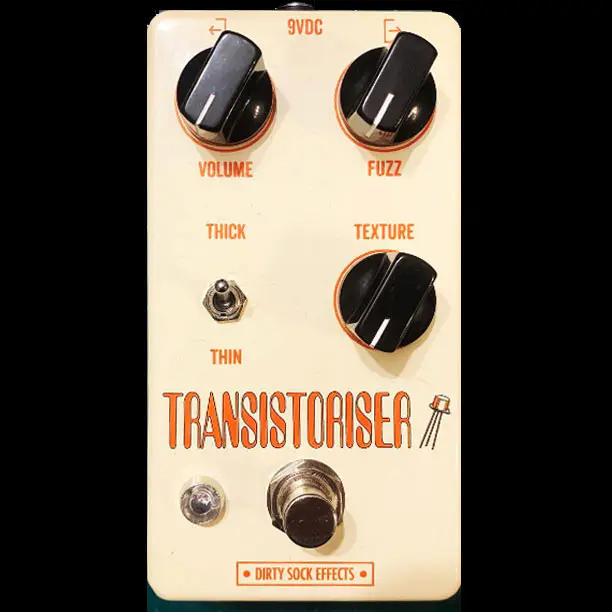
Inspired by pioneering silicon fuzz designs of the late ’60s/early ’70s like the Shin Ei FY-2 and the Mosrite Fuzzrite, the Dirty Sock Effects Transistoriser hails from Sidney, Australia.
Although its sound is vintage, the components in the circuit were updated to modern standards, with the goal of making this pedal more versatile and… loud! The latter characteristic allows it to better interact with your amp, whereas old vintage units struggle to get to unity gain.
The Fuzz and Texture knobs work interactively to produce a variety of tones, with the latter blending in an extra transistor stage for an extra layer of gain which tends to emphasize upper harmonics, making the tone cut through more easily through dense mixes.
The Thin/Thick switch changes the tone’s lower-end content, with the former sounding a lot tighter, and the latter working better on bass guitar.
Here’s a video of it.
Dirty Sock Effects Transistoriser, Builder’s Notes
The Transistoriser is inspired by some of my favourite and most underrated silicon fuzz boxes from the late 60s/early 70s – like the Shin Ei FY-2 and the Mosrite Fuzzrite, but with some very welcome modern updates. These old fuzzes are well known to be sort of ‘one-trick ponies’, so I’ve made every effort to make the Transistoriser as versatile as possible.
Firstly, unlike many vintage fuzzes that struggle to get to unity gain, the Transistoriser has plenty (and I mean plenty) of output level on tap, and unity gain sits at a little under 4 on the volume control.
The fuzz control has a very broad range too, from spitty low gain drive to a blown-out silicon fuzz when turned all the way up.
The fuzz control’s best friend is the texture control – they’re very interactive and shape the character of the fuzz significantly. The texture control blends in an extra transistor stage, bringing with it a collection of interesting upper harmonics, and some extra gain. This means turning it up can help riffs cut, but also turning it down can make the Transistoriser play a little nicer with chords and more complex parts 🙂
The final piece of the puzzle is the thick/thin switch, which alters the bass content of the pedal. With some darker voiced guitars the low end in the Transistoriser can get a little intense, so switching the switch to thin can help riffs cut much better in a mix and stop things from getting too crazy. This also applies to basses (did I mention it LOVES bass), where the ‘thin’ setting can cut a little low end, that the ‘thick’ setting can reintroduce.
Overall it’s a very versatile silicon fuzz box capable of some really unique fuzz sounds that haven’t been explored by other modern fuzzes, with some familiar tones in there too!
Controls
Volume – Amount of output level
Fuzz – Amount of ‘fuzz’, turning it down can get into overdrive territory, and turning it up gradually increases the pedal’s fuzziness
Texture – Blends in an extra transistor stage, which introduces more upper harmonics, gain and a little extra fuzziness
Thick/Thin – Alters the pedal’s bass response, helping you tune it to your guitar/bass and amp setup.Power:
The Transistoriser takes standard (boss style) 9VDC centre negative power, with a 2.1mm barrel. Do not run it on anything else!All Dirty Sock Effects have a lifetime warranty against manufacturing defects and normal wear and tear. If it breaks, I will fix it 🙂






















